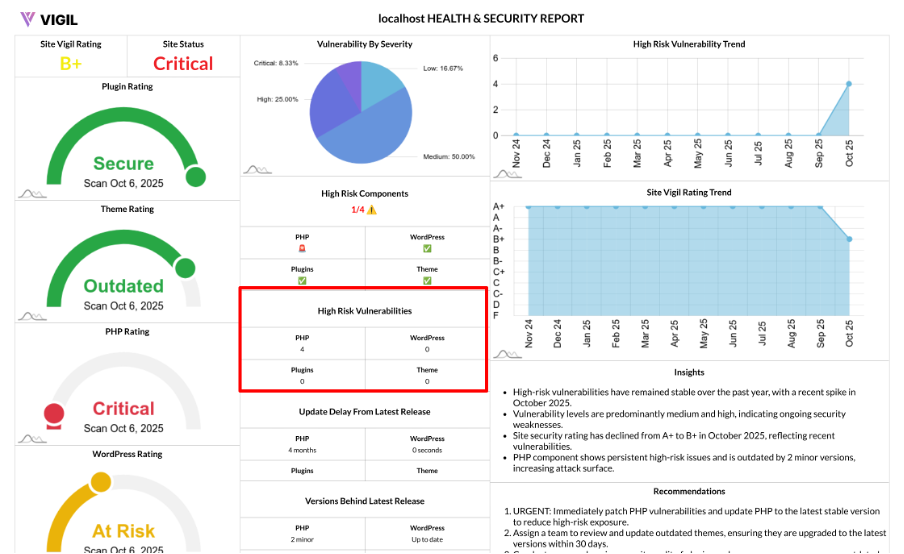High Risk Vulnerabilities: Zeroing In on Your Most Urgent Risks
High Risk Vulnerabilities highlights the most critical issues that are most likely to impact your site right now. It focuses exclusively on High and Critical severities across four key components—PHP, WordPress core, your active theme, and active plugins—so you can act where it matters most.
What It Shows
The High Risk Vulnerabilities section provides a breakdown of High and Critical vulnerabilities per component:
- PHP
- WordPress core
- Active theme
- Active plugins
It gives you a combined view that allows you to spot which component is driving the greatest risk, so you can prioritize your actions effectively.
How It Works
We pull the High and Critical vulnerability counts for each component, then combine them into a single number per component. The result is a compact breakdown that you can:
- Chart visually for easier interpretation
- Summarize in reports to communicate your site's security posture
Why It Matters
High Risk Vulnerabilities is an essential tool for several reasons:
- Prioritization: Targets the vulnerabilities that are most likely to have a major impact on your site.
- Speed: Cuts through the noise from Medium/Low issues, surfacing the most urgent problems that require immediate action.
- Clarity: Shows exactly where the risk is clustered—whether in plugins, the theme, core, or PHP—so you know where to focus your efforts.
How to Use It
Here’s how to act based on where the highest risks lie:
- If Plugins are the highest: Patch or replace the specific vulnerable plugin(s) first.
- If the Theme is the highest: Update your active theme or switch to a maintained alternative.
- If WordPress Core is affected: Update WordPress immediately and validate critical workflows.
- If PHP is affected: Move to a supported PHP version and apply necessary security updates.
Quick Wins to Reduce High Risk
To quickly reduce High Risk Vulnerabilities:
- Patch Critical vulnerabilities first, then tackle High issues before addressing Medium/Low ones.
- Remove unused or abandoned plugins/themes to reduce your exposure.
- Standardize monthly maintenance and enable update notifications to stay on top of potential vulnerabilities.
- Use a Web Application Firewall (WAF) and follow the principle of least privilege as mitigations while patching.
Outcome
By addressing High and Critical issues one component at a time, you’ll see immediate improvements in your site’s overall Site Status and Site Vigil Rating. With fewer exploitable paths and a stronger security posture, your site will be more resilient to attacks and vulnerabilities.

